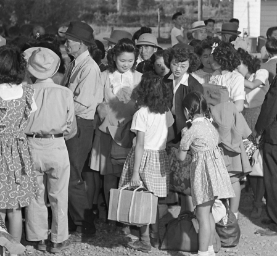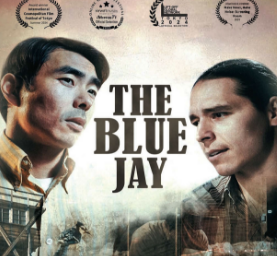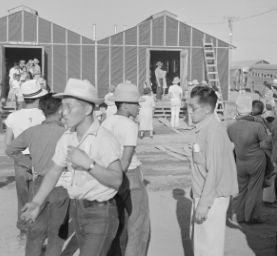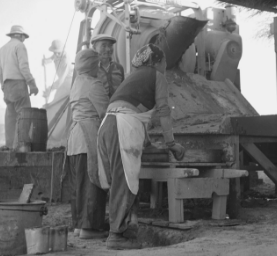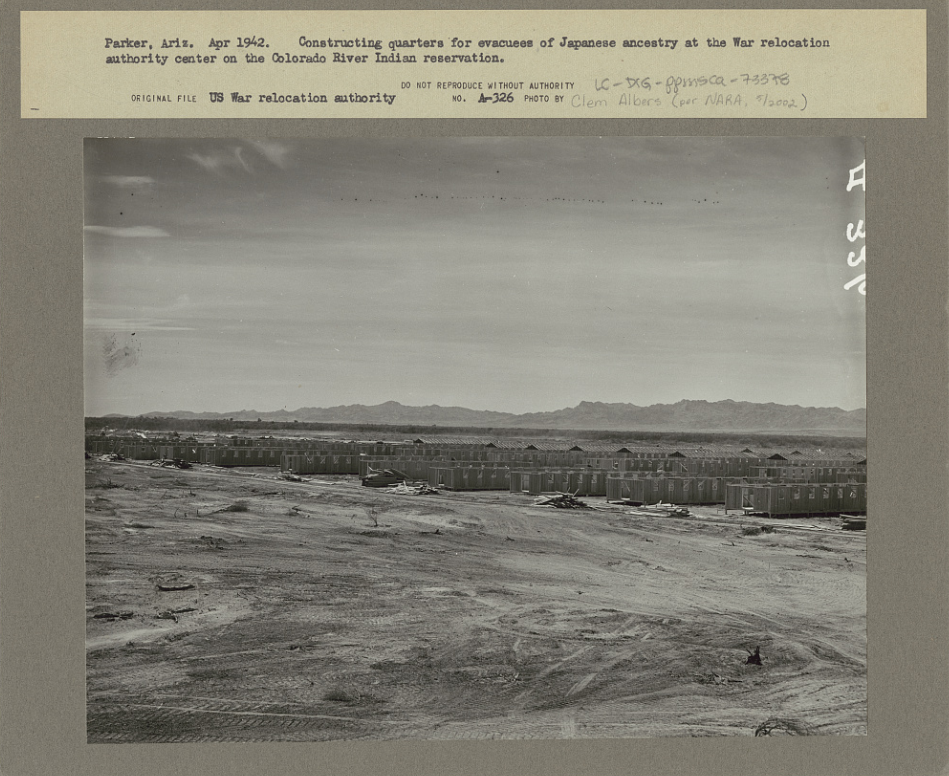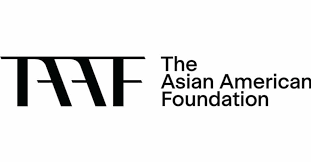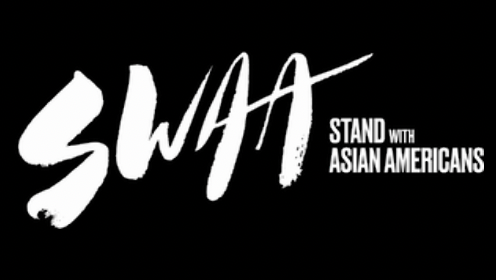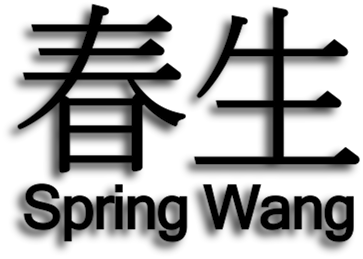“The Blue Jay,” a short-form narrative film on the Poston Incarceration Camp.
Credit: Written/Directed/Produced by Marlene Shigekawa, Marshig Productions
Grade: 9-12Subject:
U.S. History, Social Studies, English Language Arts
Number of Lessons/Activities: 4
During World War II (1939-1945), 120,000 Japanese Americans living on the West Coast were forcibly incarcerated in camps. Of those, roughly 18,000 were sent to the Poston Incarceration Camp near Parker, Arizona, which was built on the site of the Colorado River Indian Reservation. In this lesson, students will learn about the history of the Poston Incarceration Camp. Students will examine life in the Poston Incarceration Camp through viewing a clip from the narrative film, The Blue Jay. They will examine the perspectives of the War Relocation Authority, the Office of Indian Affairs, and the Colorado River Indian Tribe Tribal Council, and how the different interests of these organizations led to the formation of the Poston Incarceration Camp.
Students will:
- Analyze reasons for the establishment of the Poston Incarceration Camp at the Colorado River Indian Reservation during World War II (1939-1945).
- Examine the geography of the Colorado River Indian Reservation and its implications.
Establishment of Poston Incarceration Camp Essay:
On December 7, 1941, Japan attacked Pearl Harbor, a U.S. naval base near Honolulu, Hawai
ʻi. In response the next day, the United States formally entered World War II (1939-1945). The attack on Pearl Harbor escalated racial prejudice toward the Japanese American community, who were accused of being spies and/or disloyal. On February 19, 1942, President Franklin D. Roosevelt (1882-1945), in the name of national security, signed Executive Order 9066, which ordered the
incarceration of 120,000 Japanese Americans living on the West Coast. Many Japanese American families lost their homes, businesses, farms, and more. They were denied their civil rights and suffered inhumane treatment. By the end of the war, not a single incarcerated Japanese American was found guilty of espionage.
The War Relocation Authority (WRA) was a civilian agency authorized to oversee the resettlement of Japanese American incarcerees and to construct ten incarceration camps – with support from the U.S. military. The WRA was responsible for supervising all activities in the camps. It established five requirements for incarceration sites: (1) The site must be on public land, (2) The site must be adequate for large projects, (3) The site must provide work opportunities throughout the year, (4) The site must be located at a safe distance from strategic work (e.g. military bases), and (5) The site must have satisfactory transportation and power facilities, water supply, and climate.
The
Poston Incarceration Camp, referred to during the war as the
Colorado River Relocation Center, near Parker, Arizona eventually became the largest of the ten camps. Named after Colonel Charles D. Poston (1825-1902), the first Superintendent of Indian Affairs in the Arizona territory, it was one of two camps located on a Native American
reservation. The Colorado River Indian Reservation (CRIR) was established by Congress on March 3, 1865. (The Gila River Camp was also on a reservation in Arizona.) As one member of the Colorado River Indian Tribes (CRIT) put it, Japanese American incarcerees lived “on a reservation within a reservation.”
The CRIR reservation site was selected because of its strategic location on the bank of the Colorado River. The U.S. government planned to construct an
irrigation canal there so that the reservation could be self-sufficient. This turned out to be very difficult and several years of construction failed. In 1941, the Headgate Rock
Dam was finally built. A main canal was started to connect the dam to the CRIR, but by the time WWII began, only a few miles of the canal had been completed.
Prior to 1865, several Indigenous
tribes lived on this land. The largest was the Mohaves. In the mid-19th century, White settlers, supported by the U.S. Army, began to encroach on the land, leading to years of warfare and resistance by the Mohaves against the U.S. Army. With the establishment of the CRIR in 1865, one of the U.S. government’s goals for the reservation was to “colonize* some 10,000 Indians.” They hoped to assemble all the tribes living along the Colorado River to this reservation. However, this did not happen.
When John Collier (1884-1968), Commissioner of the Office of Indian Affairs (OIA, now the Bureau of Indian Affairs) found out that the WRA needed land to build incarceration camps during WWII, he suggested CRIR as a site for a camp. This would help the OIA meet its goal of developing the irrigation system. This was important because access to additional water could make the reservation land more productive. They needed support digging irrigation ditches, building canals, leveling the land, and preparing the land for receiving water and planting crops. The OIA saw an opportunity to use the Japanese Americans incarcerees as laborers to construct a workable irrigation system.
Turning CRIR into an incarceration camp would also help OIA meet another of its original goals: to colonize the CRIR. During this time, Native Americans living on other southwestern reservations were struggling to make a living off their
arid land. Overgrazing and lack of water were the primary causes. The OIA’s plan was for Native Americans to settle there when the Japanese American incarcerees eventually left Poston. This meant they would also need school facilities. And so the OIA planned to have
adobe brick school buildings built by the Japanese American laborers.
Thus, three governmental agencies – the military, the WRA, and the OIA – cooperated to form the Poston Incarceration Camp. From the OIA’s perspective, the creation of the Poston Incarceration Camp provided direct access to President Roosevelt’s emergency war fund to construct the irrigation system, implement a colonization program, and construct adobe school buildings. From the WRA and military’s perspectives, Poston provided a much-needed site for an incarceration camp, which were justified as necessary wartime security measures. As an added bonus, the OIA covered the payroll cost of the administrative staff so the WRA did not need to staff and manage the camp.
There was one major party however that did not approve of this plan: the Colorado River Indian Tribe (CRIT) Tribal Council. They adamantly opposed both the Poston Incarceration Camp and the colonization program. But they were in a terrible bind. If they rejected the WRA and OIA’s demands, their land could be permanently lost to the government or to White farmers. If they agreed, they would be condoning the act of incarcerating a group of innocent people on their reservation, which they did not support. Faced with this dilemma, the CRIT Tribal Council decided not to respond.
Despite the opposition of the CRIT, the Poston Incarceration Camp was set to be built. It opened in late May 1942 and eventually incarcerated over 18,000 Japanese Americans.
This text is an excerpt from the “Sharing a Desert Home: Life on the Colorado River Indian Reservation” by Ruth Y. Okimoto. It has been adapted for reading accessibility and clarity. Access to the original text can be purchased through the Poston Community Alliance.
* U.S. government officials in the 1940s used the terms “colonists,” “colonize,” and “colonization” to refer to their plan of having Native Americans live and work on a designated piece of land. These terms are complex and laden with meaning, especially for Native Americans who have had their land forcibly stolen by settlers and the U.S. government for centuries. These terms will be more deeply analyzed in Lesson 3: Poston After WWII. For the purpose of this article and to be true to the historical government records, this essay uses these terms as they were recorded and used.
Bibliography:
Okitomo, Ruth Y. (2001). Sharing a Desert Home: Life on the Colorado River Indian Reservation. Berkeley, CA: Heyday Books.
- Adobe brick: material made of earth (mud), water, and straw or grass
- Arid: excessively dry
- Colorado River Relocation Center: the term used by the War Relocation Authority to identify the Poston “internment site” to detain Japanese Americans
- Dam: a barrier preventing the flow of water
- Incarceration: confinement in a jail or prison
- Irrigation: the watering of land by artificial means to foster plant growth
- Poston Incarceration Camp: the term currently used for the “Colorado River Relocation Camp” to convey that the camps were concentration camps where U.S. citizens of Japanese descent were denied due process, freedom, and their Constitutional rights
- Reservation: a federal Indian reservation is an area of land reserved for a tribe or tribes under treaty or other agreement with the United States, executive order, or federal statute or administrative action as permanent tribal homelands, and where the federal government holds title to the land in trust on behalf of the tribe.*
- Tribe: a social group composed chiefly of numerous families, clans, or generations having a shared ancestry and language
- Why were Japanese Americans incarcerated during World War II?
- What was the War Relocation Authority (WRA)? What was their purpose?
- What is the significance of the WRA’s five criteria for incarceration sites?
- Why was the Poston Incarceration Camp set up on the Colorado River Indian Reservation (CRIR)?
- What were the original goals of the CRIR?
- What was the Colorado River Indian Tribes’ (CRIT) perspective on the WRA/OIA plans?
Unfinished barracks on Colorado River Indian Reservation land that was taken by the U.S. government to incarcerate Japanese Americans during World War II at Poston War Relocation Center in Parker, Arizona. This photo was taken in April 1942, one month before the first incarcerees arrived.
Photographer: Clem Albers, 1942. War Relocation Authority. Library of Congress. (No known restrictions on publication.)
Activity 1: Analyzing The Blue Jay - Part 1
- Show 0:00-5:16 from the film, The Blue Jay.
- Tell students that this film is about the Poston Incarceration Camp, one of ten camps set up by the U.S. government to incarcerate Japanese Americans during World War II. Tell students that this camp was unique in that it was initially established as a Native American reservation.
- Facilitate a discussion by asking the following questions:
- What is the setting of this film?
- How does the film portray life for Japanese Americans at Poston? What hardships did they face?
- How does this clip portray the relationship between Japanese American incarcerees and Native Americans at Poston Incarceration Camp?
- What does Pohache mean when he says, “What do you know? A new kind of sheriff on the res. They ought to pay us rent.” (2:18)? How do Sam and Pohache each view the land that they are on?
- Based on this clip, what message do you think the filmmaker is trying to convey?
- What questions did the first part of the film evoke?
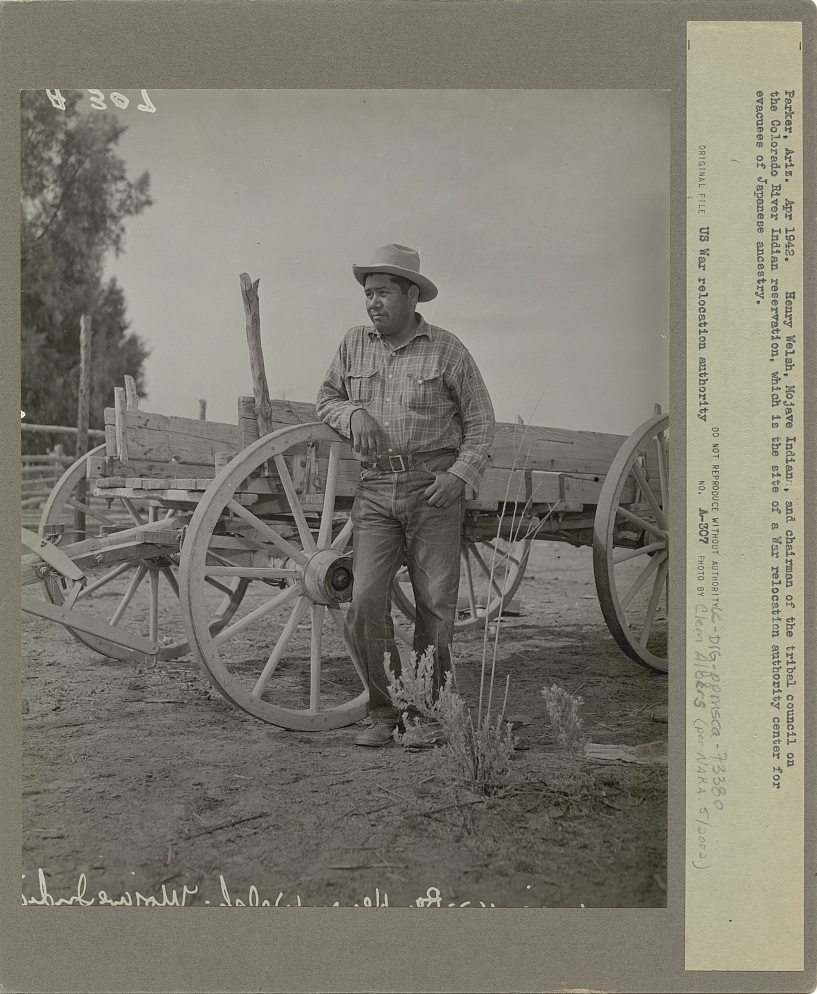
Henry Welsh, a Mojave Indian, was chairman of the Colorado River Indian Reservation Tribal Council. The Tribal Council adamantly opposed the creation of the Poston Incarceration Camp on their reservation.
Photographer: Clem Albers, 1942. War Relocation Authority. Library of Congress. (No known restrictions on publication.)
Activity 2: Evaluating Goals and Advantages
- Have students read the essay. Consider the following options:
- OPTION 1: Have students read the essay independently either for homework or during class time.
- OPTION 2: Read aloud the essay and model annotating.
- OPTION 3: Have students read aloud in pairs or small groups.
- Facilitate a class discussion by asking students the Discussion Questions listed above.
- Distribute the worksheet entitled, “Goals and Advantages.” Have students use the essay to complete the chart:
- Have students list the goals of each entity (WRA, OIA, CRIT) in the middle column.
- Have students list the advantages to each entity with the creation of the Poston Incarceration Camp in the right column.
- Have students explain the dilemma the CRIT faced regarding the creation of the Poston Incarceration Camp in the “Advantages” column.
- Have students write a paragraph addressing this prompt: Why was an incarceration camp set up at the CRIR? Who was affected by this and how?
- Facilitate a class discussion by asking students the following questions:
- What were the pros and cons of using the CRIR as an incarceration camp?
- How did this action benefit some groups over others?
- Why did some groups’ advantages matter more than other groups’ disadvantages?
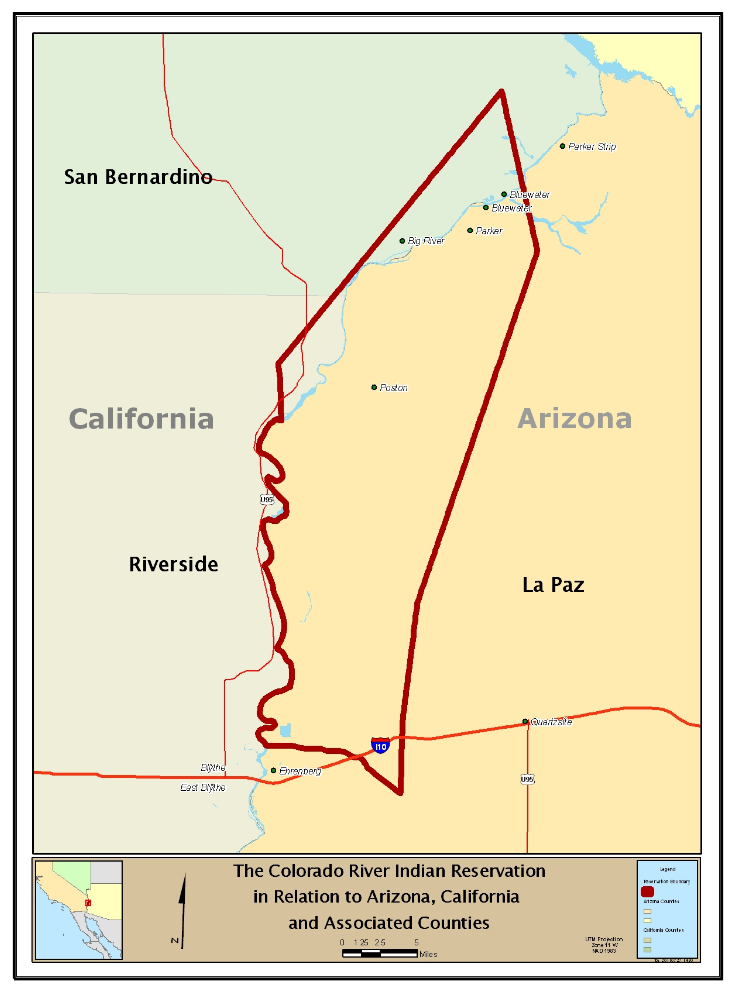
Map of the Colorado River Indian Reservation, which is mostly in La Paz County, Arizona, with smaller portions in San Bernardino and Riverside Counties, California.
Photographer: Cenglish, CC0, via Wikimedia Commons
Activity 3: Examining the Geography of the Colorado River Indian Reservation
- Have students review the “Goals and Advantages” worksheet and highlight anything they listed that relates to the geography of the Colorado River Indian Reservation.
- Have students locate CRIR on a map and describe its geographic location.
- Have students answer the following questions:
- Which two states does the CRIR have land in?
- Where is the CRIR relative to the Colorado River?
- Have students look online to answer the following questions:
- What is the average temperature in the area each season?
- What is the average precipitation (rainfall) in the area each season?
- Have students read sections “5.8.1 Introduction,” “5.8.2 Physical Setting,” and “5.8.3 Historical Use and Cultural Importance of Water in the report entitled, “Chapter 5 – Assessment of Current Tribal Water Use and Projected Future Water Development” to learn more about the geographic characteristics of the CRIR.
- Facilitate a discussion by asking the following questions:
- What are the geographic characteristics of the CRIR?
- What are the implications of these geographic characteristics for agriculture?
- Have students read the article entitled, “Irrigation.” Ask students:
- What problems does irrigation solve?
- Why would the CRIR need irrigation canals?
- Why is a labor force necessary?
- Have students reread the paragraph they wrote in Activity 2 to address this prompt: “Why was an incarceration camp set up at the CRIR? Who was affected by this and how?” Have students edit their paragraph to include information about the geography of CRIR and how this impacted the decision to set up an incarceration camp at CRIR.
- Facilitate a discussion by asking students: Why was location important in regard to the establishment of the Poston Incarceration Camp?
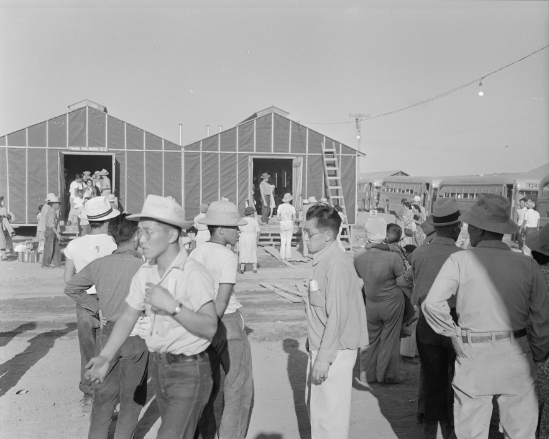
Japanese American incarcerees arrive at Poston Incarceration Camp on May 26, 1942.
Photographer: Fred Clark, 1942. National Archives. (Public Domain)
Activity 4: Examining the Establishment of the Poston Incarceration Camp
- Have students share what they know about the incarceration of Japanese Americans during WWII and what they know about Native American reservations. Have students discuss the sources of their preconceptions. Have students note what they learned from this lesson and how this lesson either changed or affirmed their preconceptions.
- Facilitate a discussion by asking the following questions:
- In what ways are incarceration camps and Native American reservations similar? In what ways are they different?
- What does it mean that the Japanese incarcerees were living “on a reservation within a reservation”?
- How were the experiences of Native Americans and Japanese Americans during this time similar? How were they different?
- How and why were the Native Americans and Japanese Americans positioned against each other?
- How did the Native Americans and Japanese Americans demonstrate cross-cultural solidarity?
- Have students write an essay addressing the following prompt: “How did the goals and decisions of the War Relocation Authority (WRA), Office of Indian Affairs (OIA) and Colorado River Indian Tribes (CRIT) lead to the formation of the Poston Incarceration Camp?”
- Have students watch the video entitled, “Ruth Okimoto | Maybe You Can Go Home Again.” Explain how in this video, Ruth Okimoto, the author of “Sharing a Desert Home: Life on the Colorado River Indian Reservation,” shares and reflects on her experience at Poston Incarceration Camp. Have students discuss the significance of learning about Poston’s history.
- Implement AAEdu’s lessons entitled, “The Contributions of the Chinese Transcontinental Railroad Workers” and “Sikhs in the Borderlands.” Explain how this country was built on immigrant labor (i.e., Chinese immigrants on the railroads and South Asian immigrants in agriculture), in addition to the labor of enslaved Africans and Native Americans. Have students write an essay about how and why Asian labor was used in the United States and for what purposes. Have students discuss the contributions of Asian labor and how we continue to see their legacies today.
